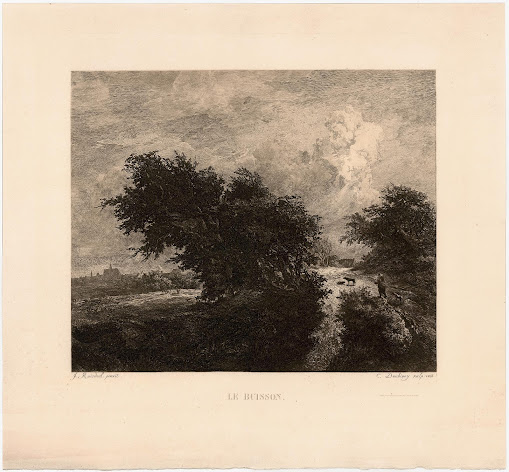Charles Daubigny (aka
Charles François Daubigny) (1817–1878)
“Le
Buisson” (aka “The Scrub”; “The Thicket”), 1855, after Jacob van Ruisdael 's (aka
Jacob van Ruysdael; Jacob Isaaksz van Ruisdael; Jacob de Goyer) (1628/9–1682) painting, 1647/53, “Dune
Landscape near Haarlem” (aka "Le Buisson ou Chemin dans les dunes
harlemoises"), in the Musée du Louvre, Paris (inv. no. 1819) (see: https://en.wikipedia.org/wiki/Dune_Landscape_near_Haarlem), commissioned and published by the
Etching and drypoint printed in brown (bistre)
ink on heavy cream wove paper, blind-stamped with the Chalcographie du Louvre
seal.
Size: (sheet) 51 x 54.8 cm; (plate) 42.9 x 47.8
cm; (image borderline) 32.8 x 39.7 cm.
Lettered in plate below the image borderline:
(left) “J.Ruisdael pinxit.”; (centre) “LE BUISSON.”; “C. Daubigny sculp 1855/ CHALCOGRAPHIE
DU MUSÉE DU LOUVRE.”
Blind-stamped on lower margin with the seal of
“Chalcographie du Louvre, Musées Nationaux”.
State v (of v) with the addition of the title
and publication details of the Chalcographie.
Melot D87 S5 (Michel Melot 1978, “Graphic Art
of the Pre-Impressionists”, New York, Harry N. Abrams, p, 278, cat. no. D 87 [5]);
Delteil 87 (“Le Peintre-Graveur Illustré (XIXe et XXe siècles”).
Michel Melot (1978) offers the following
insights about the background events in Daubigny’s life leading up to the
execution of this plate:
“The Comte de Nieuwerkerke, Director-General
of Museums, assigned Daubigny to translate the “Thicket” of Ruysdael, which no
engraver had as yet taken on. Daubigny acquitted himself of this delicate task
very honourably. He rendered the masterpiece of the Master of Haarlem not as a
clever manipulator of cross-hatchings but as a painter interpreting another
painter and penetrating directly into the feeling of the model. He attained the
power of effect of the original and at the same time expressed its austere
melancholy. Following the example of the masters of the great periods of
engraving, Daubigny executed his plate with a great simplicity of means. He
made use of scarcely anything more than etching and drypoint. He made little or
no use of the burin. He rigorously ruled out the use of roulettes and other
mechanical means. He made up for them by energetic and repeated [acid] baths;
his work owes its frankness and vigour to those audacities in acid-biting, but
the drawing was to some extent made heavier, and the plate lost by this a
little of the spirit and finesse that distinguish the ‘first state’ of pure etching so sought after by print lovers” (p. 278; see also the original
text written that Melot translated written by Comte de Nieuwerkerke’s
secretary, Frédéric Henriet, in 1875 in “C. Daubigny et son oeuvre gravé,
eaux fortes et bois inédits”, Paris, A. Lévy, pp. 60–61: https://archive.org/details/cdaubignyetsonu00henrgoog/page/n80/mode/2up).
The Metropolitan Museum of Art offers a
description of this print: https://www.metmuseum.org/art/collection/search/336989.
Condition: a richly inked and well-printed impression with generous margins as published in near pristine condition.
I am selling this large and richly worked etching executed by one of the luminaries of the Barbizon School after a painting by one of the major landscape artists of the 1600s, for the total cost of AU$289 (currently US$199.21/EUR199.71/GBP169.82 at the time of this listing) including postage and handling to anywhere in the world, but not (of course) any import duties/taxes imposed by some countries.
If you are interested in superb etching which is one of Daubigny’s major commissioned works by the Louvre—interestingly, the print was commissioned by the director of the Louvre at a time when artists’ reproductive rights were being challenged by a proposed law in 1841 designed to prevent “the government of conducting itself like an owner and publisher with money taken from the Civil List” (see Frédéric Henriet [1875] p. 60)—please contact me (oz_jim@printsandprinciples.com) and I will send you a PayPal invoice to make the payment easy.
This print has been sold











No comments:
Post a Comment
Please let me know your thoughts, advice about inaccuracies (including typos) and additional information that you would like to add to any post.